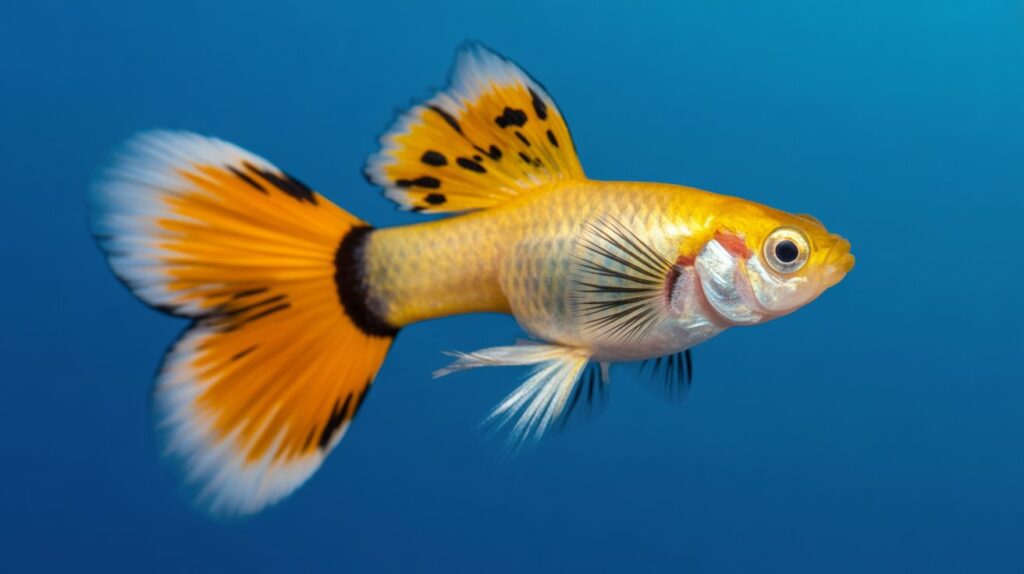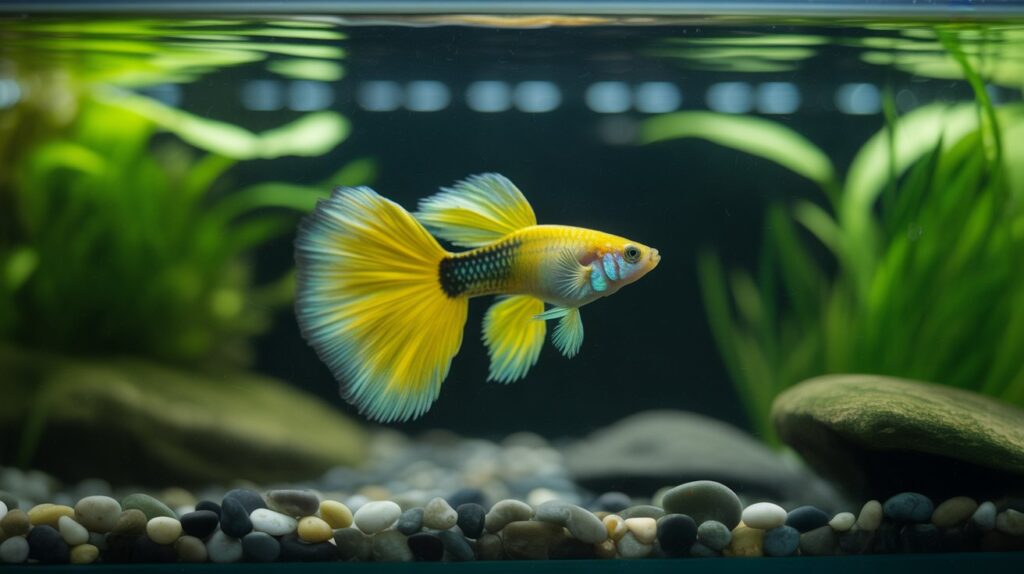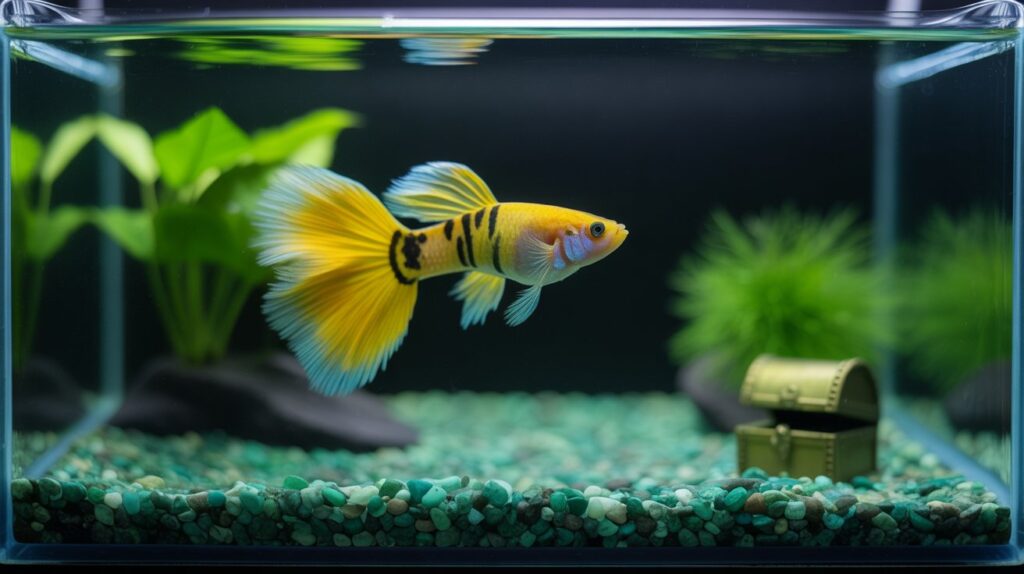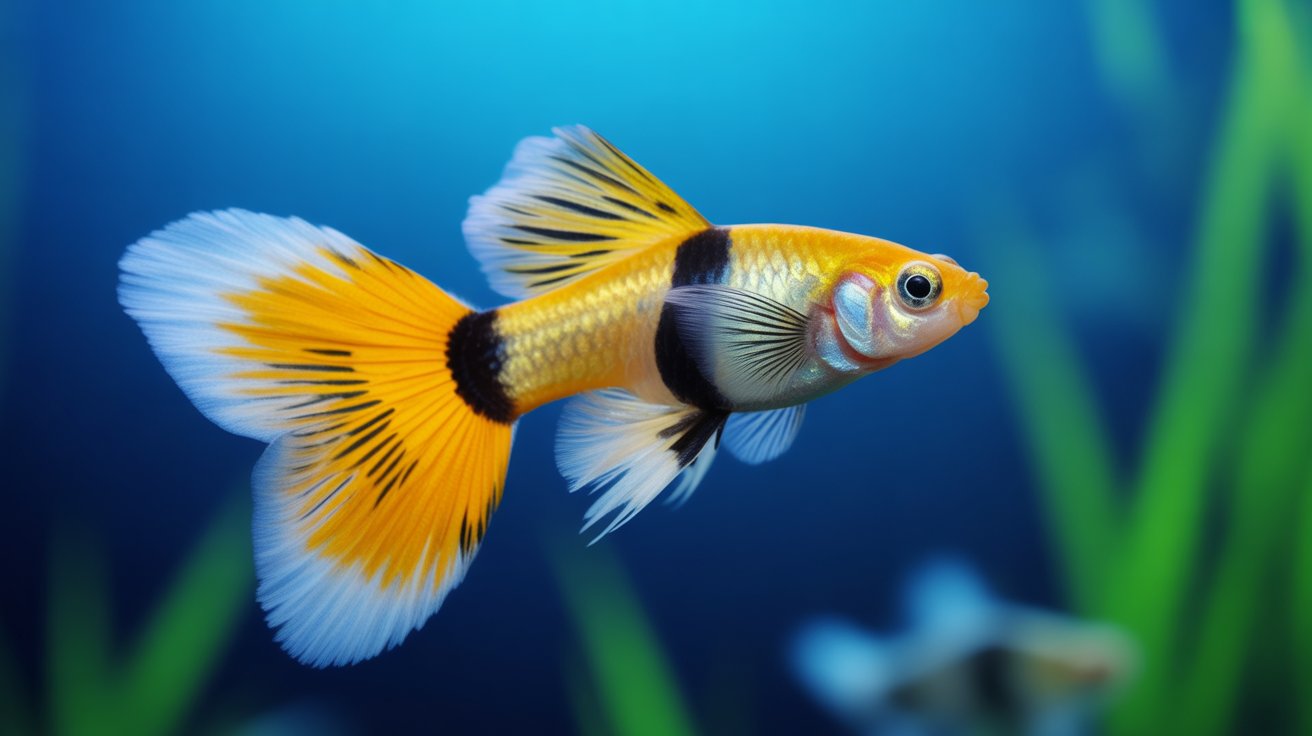The Yellow Tiger Guppy is one of the most visually captivating strains in the guppy world. With its fierce black tiger stripes across a radiant yellow tail and body, this guppy demands attention. It’s an ideal blend of wild aesthetics and ornamental elegance, making it a favorite among aquarium enthusiasts and breeders.
Known for its vibrant coloration, active temperament, and relatively easy care, the Yellow Tiger Guppy is an excellent choice for both beginner and experienced aquarists. This article will explore everything you need to know about this unique guppy variety—from its origins and appearance to care, breeding, and common FAQs.
1. Introduction to the Yellow Tiger Guppy
The Yellow Tiger Guppy is a selectively bred strain of Poecilia reticulata, a species native to South America. What makes this guppy stand out is its bold black “tiger stripe” pattern spread across a glowing yellow tail and occasionally along its body. The combination of wild patterns with bright coloration is striking, giving the fish a “mini-jungle” look.
In addition to its visual appeal, the Yellow Tiger Guppy is hardy, social, and breeds prolifically. It is well-suited for community tanks, nano aquariums, and breeding projects.
2. History and Genetic Origins

The tiger pattern in guppies is a result of selective breeding, aimed at producing stripes that resemble the markings of a tiger. The Yellow Tiger Guppy was developed by combining guppies that carried strong tiger tail genes with those that expressed dominant yellow coloration.
Originating in Asia, particularly Thailand and Indonesia, this strain quickly gained popularity due to its fiery appearance and compatibility with other tropical fish. Over time, breeders have improved the intensity of both the yellow color and the black striping.
3. Unique Physical Characteristics
The Yellow Tiger Guppy is a visual masterpiece, known for its contrast-rich body and tail patterns.
Key Features:
- Body Color: Light to medium yellow, often metallic
- Tail and Fins: Large, flowing fins with dark black tiger-like stripes over a bright yellow base
- Size:
- Males: 1.2–1.6 inches (3–4 cm)
- Females: 2.0–2.5 inches (5–6 cm)
Tail Types:
- Fan tail
- Delta tail
- Occasionally lyretail in designer strains
The tail is usually the most striking part, often covering a wide fan-shaped area with distinct black striping against yellow, resembling a tiger’s markings.
4. Male vs Female Yellow Tiger Guppies
Distinguishing between males and females is crucial, especially for breeding.
| Feature | Male | Female |
|---|---|---|
| Size | Smaller and slimmer | Larger and more rounded |
| Color Pattern | Bold, vivid yellow with tiger stripes | Subtle or muted striping |
| Tail | Long and decorative | Shorter and plainer |
| Gravid Spot | Absent | Present near anal fin |
| Behavior | Energetic, constantly chasing females | More reserved |
Males are prized for their vivid markings, while females are essential for breeding continuity.
5. Behavior and Temperament

Yellow Tiger Guppies are active, peaceful, and social fish. They thrive in community tanks and interact well with other guppies and non-aggressive species.
Behavioral Highlights:
- Constant swimmers, especially males during courtship
- Non-territorial and friendly
- Prefer to school with others of their kind or similar size
To reduce stress, it’s best to keep them in groups of at least 6.
6. Tank Setup and Environment
Creating a proper tank environment will allow your Yellow Tiger Guppies to flourish and show off their vibrant patterns.
Tank Setup Recommendations:
- Tank Size: Minimum 10 gallons for a small group
- Substrate: Fine gravel or sand
- Plants: Java moss, Guppy grass, Water sprite
- Lighting: Moderate to bright LED (brings out yellow color)
- Filter: Sponge or low-flow HOB filter
- Decor: Driftwood, stones, floating plants for fry cover
A well-planted tank with low to moderate current is ideal.
7. Water Parameters and Maintenance
Yellow Tiger Guppies, like most guppy strains, are adaptable but prefer stable water conditions.
- Temperature: 74°F – 82°F (23°C – 28°C)
- pH: 6.8 – 7.8
- Hardness: 8 – 12 dGH
- Ammonia/Nitrite: 0 ppm
- Nitrate: <20 ppm
Maintenance:
- Weekly water changes (20–30%)
- Test water regularly using liquid test kits
- Clean the substrate and remove uneaten food
8. Feeding and Diet
Yellow Tiger Guppies are omnivorous and enjoy a wide variety of food. A well-balanced diet enhances both health and coloration.
Recommended Diet:
- Staple: High-quality guppy flakes or micro-pellets
- Live/Frozen: Brine shrimp, bloodworms, daphnia
- Vegetable Matter: Spirulina flakes, blanched spinach
- Treats: Mosquito larvae, tubifex worms (occasionally)
Feed 2–3 times a day, in amounts they can finish in under 2 minutes.
9. Compatible Tank Mates

These guppies are peaceful and do well with other community fish of similar size and temperament.
Good Tank Mates:
- Neon Tetras
- Platies
- Mollies
- Endler’s Livebearers
- Corydoras Catfish
- Cherry Shrimp
- Nerite Snails
Avoid:
- Aggressive fish (Bettas, Tiger Barbs)
- Fin nippers
- Large predatory fish
10. Breeding Yellow Tiger Guppies
Guppies are livebearers and one of the easiest aquarium fish to breed.
Breeding Setup:
- Keep 1 male with 2–3 females
- Provide hiding spots for fry
- Use a breeding box if needed
- Increase temperature slightly (78–80°F) to stimulate breeding
Gestation:
- 21–30 days
- Females give birth to 20–60 fry per batch
11. Raising Fry Successfully
Fry need protection from adults and specific care to survive and develop full coloration.
Fry Care Tips:
- Move fry to a separate grow-out tank
- Feed crushed flakes, infusoria, baby brine shrimp
- Perform frequent water changes (10–20% every 2–3 days)
- Provide low-current filtration and live plants
Fry will start showing tiger patterns around 3–4 weeks of age.
12. Common Health Concerns
Though hardy, Yellow Tiger Guppies can face typical tropical fish illnesses.
Common Diseases:
- Ich (white spot disease)
- Fin Rot
- Swim Bladder Disorder
- Fungal Infections
- Internal parasites
Prevention:
- Quarantine new fish
- Maintain clean, stable water
- Feed a balanced diet
- Watch for signs like clamped fins, erratic swimming, or loss of color
13. Enhancing Color and Lifespan
To keep your Yellow Tiger Guppies looking their best and living longer:
- Provide proper lighting to enhance yellow and black contrast
- Use color-enhancing foods like spirulina and brine shrimp
- Avoid stress with compatible tank mates and stable conditions
- Ensure clean water with regular maintenance
With good care, they can live 2 to 3 years.
14. Purchasing Tips and Price Guide
Yellow Tiger Guppies are available from local pet stores, online shops, and breeders.
Price Range:
- $3 to $10 per guppy, depending on size and quality
- Breeding pairs or trios may cost more
What to Look For:
- Bright yellow with well-defined black stripes
- Active swimming behavior
- Clear eyes and full, untorn fins
- No signs of disease or stress
15. Conclusion
The Yellow Tiger Guppy is a stunning and bold addition to any freshwater tank. With its exotic tiger-stripe pattern and golden-yellow glow, it’s a showstopper that also offers easy maintenance and active personality. Whether you’re starting your first guppy tank or expanding a designer strain collection, the Yellow Tiger Guppy is a vibrant choice.
Provide the right care, a well-maintained environment, and a nutritious diet—and you’ll be rewarded with a dazzling display of movement and color.
16. FAQs
Q1: Are Yellow Tiger Guppies easy to care for?
Yes. They are hardy and beginner-friendly, needing basic maintenance and clean water.
Q2: How long do Yellow Tiger Guppies live?
2 to 3 years with proper care and water quality.
Q3: Do Yellow Tiger Guppies breed easily?
Yes. Like all guppies, they are prolific breeders and can reproduce monthly.
Q4: Can I keep them with shrimp?
Yes. They are peaceful and coexist well with Cherry or Amano shrimp.
Q5: How can I make their colors more vibrant?
Feed a varied, high-quality diet and provide good lighting and clean water.
Q6: Do they eat their own fry?
Yes. Adults may eat fry, so it’s best to separate or provide dense plants for hiding.
Q7: Can I keep only males to avoid breeding?
Yes. An all-male tank is colorful and prevents overpopulation.

